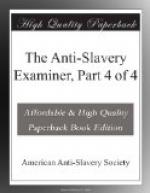[Footnote 6: Jeremiah, xxii. 13.]
[Footnote 7: Isaiah, lviii. 6, 7.]
[Footnote 8: Joel, iii. 3.]
“THOU THOUGHTEST THAT I WAS ALTOGETHER SUCH AN ONE AS THYSELF.”
In passing by the worst forms of slavery, with which he every where came in contact among the Jews, the Savior must have been inconsistent with himself. He was commissioned to preach glad tidings to the poor; to heal the broken-hearted; to preach deliverance to the captives; to set at liberty them that are bruised; to preach the year of Jubilee. In accordance with this commission, he bound himself, from the earliest date of his incarnation, to the poor, by the strongest ties; himself “had not where to lay his head;” he exposed himself to misrepresentation and abuse for his affectionate intercourse with the outcasts of society; he stood up as the advocate of the widow, denouncing and dooming the heartless ecclesiastics, who had made her bereavement a source of gain; and in describing the scenes of the final judgment, he selected the very personification of poverty, disease and oppression, as the test by which our regard for him should be determined. To the poor and wretched; to the degraded and despised, his arms were ever open. They had his tenderest sympathies. They had his warmest love. His heart’s blood he poured out upon the ground for the human family, reduced to the deepest degradation, and exposed to the heaviest inflictions, as the slaves of the grand usurper. And yet, according to our ecclesiastics, that class of sufferers who had been reduced immeasurably below every other shape and form of degradation and distress;




